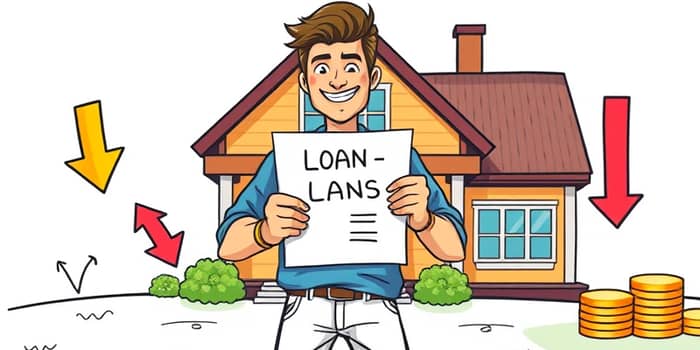In today’s ever-evolving financial environment, borrowers face a complex maze of interest rates, loan terms, and market trends. Refinancing has emerged as a powerful lever for homeowners and borrowers to reshape their finances and reduce your monthly payments. Whether you aim to lower your interest rate, shorten your repayment period, or tap into home equity, adopting a strategic approach is essential. This article will guide you through the nuances of refinancing in 2025, providing insights, data, and actionable steps to ensure you make informed decisions and maximize savings.
Refinancing a loan involves more than filling out an application. It demands careful analysis of current market conditions, a deep understanding of available options, and a clear vision for your financial goals. With interest rates on the move, borrowers who master this process can benefit from enhanced cash flow, accelerated debt repayment, and improved long-term wealth accumulation. Let’s explore the current landscape, the various refinancing paths, and the key considerations that will empower you to refinance with confidence and purpose.
Understanding the Current Refinancing Landscape
As of May 2025, average refinance rates for conventional mortgages present both opportunities and challenges. Thirty-year fixed rates hover around 7.04%, while fifteen-year fixed rates are near 6.12%. Jumbo mortgages carry slightly higher rates, and government-backed loans such as FHA and VA options offer competitive alternatives. These rates have seen subtle shifts from the previous week, indicating that timing remains crucial for prospective refinancers.
Weekly refinances have dipped slightly—30-year fixed loans fell by three basis points and 15-year fixed by ten basis points—showing lock in a lower rate windows still exist. However, high demand and fluctuating treasury yields mean rates can shift rapidly. Monitoring the Fannie Mae Refinance Application-Level Index, which reported a 6.4% weekly decline but a 15.7% annual rise, can help you gauge transaction volume and timing.
Types of Refinancing Options
Your refinancing strategy should align with your unique financial situation and goals. Understanding the main types of refinancing is the first step toward selecting the right path.
- Rate-and-Term Refinance: Adjusts interest rate, term length, or both to improve loan structure and shorten your loan term significantly.
- Cash-Out Refinance: Lets you withdraw home equity in cash for renovations, education, or debt consolidation at competitive rates.
- Streamline Refinance: A simplified process for FHA and VA borrowers, reducing documentation and expediting approval.
- Student Loan Refinancing: Consolidates federal or private student loans into one new loan, often with lower interest and flexible terms.
Key Benefits of Refinancing
Refinancing can unlock several financial advantages, but success hinges on aligning these benefits with your long-term objectives. When executed properly, a refinance lets homeowners and borrowers optimize payments and equity.
- Lower Interest Rates: Drop your interest rate by 1% or more to save thousands over the loan’s life and lower your monthly outlay.
- Shortened Loan Term: Move from a 30-year to a 15-year term to cut total interest costs and build equity faster.
- Access to Home Equity: Use cash-out refinancing to fund major expenses at rates often below credit cards and personal loans.
- Switching Loan Structures: Convert an adjustable-rate mortgage to a fixed-rate loan for maintain predictable monthly mortgage payments.
- Reduced Student Debt Costs: Consolidate multiple loans into a single payment, potentially lowering both monthly outlay and total interest.
Essential Considerations Before You Refinance
While the allure of better rates and shorter terms is strong, refinancing carries costs and risks that require careful evaluation. Fees can range from 2% to 5% of your loan amount, covering appraisal, application, and closing expenses. Factor these into your decision to ensure you calculate your break-even point before moving forward.
- Refinancing Costs: Application fees, appraisal charges, title insurance, and closing costs add up quickly.
- Break-Even Analysis: Estimate how many months it takes to recover fees through lower payments; avoid refinancing if you plan to sell before.
- Credit Score Impact: Hard inquiries may reduce scores slightly; keep shopping within a short window to limit damage.
- Loan Term and Rates: Extending terms lowers monthly payments but may increase total interest paid.
- Equity Requirements: Most lenders require a minimum of 20% equity to avoid mortgage insurance.
By taking into account ongoing rate trends and your personal financial horizon, you can determine whether the trade-offs align with your goals. For example, if rates are expected to rise, locking in a new rate sooner could be more advantageous.
Who Stands to Gain the Most?
Certain borrowers are particularly well positioned to benefit from refinancing in 2025. Homeowners with original mortgage rates above 7% can realize substantial savings by switching to current market rates under 7%. Individuals whose credit scores have improved since obtaining their initial loan may also unlock more favorable terms.
Those who have built significant equity in their homes can leverage cash-out refinancing for large expenses or debt consolidation at lower interest than unsecured borrowing. Meanwhile, borrowers juggling high-interest debt, like credit cards or personal loans, can streamline finances and reduce interest by consolidating into a single, lower-rate mortgage or student loan.
How Mortgage Refinancing Works
Refinancing replaces your existing loan with a new mortgage under revised terms. The process typically mirrors your original mortgage application, involving credit checks, income verification, and appraisal. Lenders assess your debt-to-income ratio and property value to determine eligibility.
Once approved, the new lender pays off the old loan, and you begin making payments under the new contract. Keep in mind that refinancing usually triggers a hard inquiry on your credit report, which may lower your score by a few points. However, if you maintain consistent payment history, any dip is short-lived.
Loan denials can occur if you fail to meet lender criteria, such as insufficient income or inadequate equity. Therefore, prequalifying with multiple lenders can give you a clear picture of available options without broad credit impacts.
Steps to Ensure a Smooth Refinancing Journey
Preparation and due diligence are the cornerstones of a successful refinance. Start by gathering all necessary documentation—income statements, tax returns, asset records, and debt information. Review your credit report for errors and correct any inaccuracies to ensure you secure the best offer.
Next, research lenders and loan products diligently. Solicit quotes from multiple institutions—including banks, credit unions, and online lenders—to compare APRs and closing costs. Consider both fixed and adjustable-rate options, weighing how long you’ll stay in the home against potential rate fluctuations.
When you submit your application, maintain communication with your loan officer to address any requests promptly. Stay vigilant during the appraisal process by ensuring your property is well-maintained and accessible. Finally, review the Closing Disclosure carefully to verify all terms before signing.
Conclusion: Taking Control of Your Financial Future
Refinancing is more than a transactional decision; it’s a strategic move that can reshape your financial landscape and set the stage for long-term stability. By understanding current market dynamics, evaluating all available loan types, and weighing the costs against the benefits, you position yourself to make choices that align with your goals.
Whether you aim to decrease your monthly expenses, accelerate debt payoff, or unlock equity for life’s milestones, the keys to success lie in meticulous planning, expert guidance, and timely action. Armed with these insights and a clear refinancing roadmap, you can embark on the journey to a stronger financial future with confidence and clarity.
References
- https://fortune.com/article/current-refi-mortgage-rates-05-20-2025/
- https://www.cnet.com/personal-finance/mortgages/mortgage-refinance-rates-fall-mortgage-refinance-rates-for-may-19-2025/
- https://www.cbsnews.com/news/will-you-be-able-to-refinance-your-mortgage-in-2025-what-experts-think/
- https://blog.harvardfcu.org/refinance-your-loans-is-2025-the-right-time-to-save-money
- https://kwikmtg.com/refinancing-your-mortgage-in-2025-is-it-the-right-move-for-you/
- https://www.iowastudentloan.org/articles/college/beginners-guide-to-refinancing.aspx
- https://www.fanniemae.com/data-and-insights/surveys-indices/refinance-application-level-index










